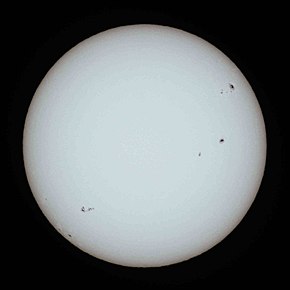starn at the centre o the Solar Seestem From Wikipedia, the free encyclopedia
The Sun is the starn at the centre o the Solar Seestem. It is a geynear perfect sphere o het plasma,[14][15] wi internal convective motion that generates a magnetic field via a dynamo process.[16] It is bi faur the maist important soorce o energy for life on Yird. Its diameter is aboot 1.39 million kilometres, i.e. 109 times that o Yird, an its mass is aboot 330,000 times that o Yird, accoontin for aboot 99.86% o the tot mass o the Solar Seestem.[17] Aboot three quarters o the Sun's mass conseests o hydrogen (~73%); the rest is maistly helium (~25%), wi muckle smawer quantities o hivier elements, includin oxygen, caurbon, neon, an airn.[18]
The "Scots" that wis uised in this airticle wis written bi a body that haesna a guid grip on the leid. Please mak this airticle mair better gin ye can. (October 2020) |
 | |
| Observation data | |
|---|---|
| Mean distance frae Yird | 1 au ≈ 1.496×108 km 8 min 19 s at licht speed |
| Visual brightness (V) | −26.74[1] |
| Absolute magnitude | 4.83[1] |
| Spectral classification | G2V[2] |
| Metallicity | Z = 0.0122[3] |
| Angular size | 31.6–32.7 meenits o arc[4] |
| Adjectives | Solar |
| Orbital chairactereestics | |
| Mean distance from Milky Way core | ≈ 2.7×1017 km 27,200 light-years |
| Galactic period | (2.25–2.50)×108 yr |
| Velocity | ≈ 220 km/s (orbit aroond the centre o the Milky Way) ≈ 20 km/s (relative tae average velocity o ither starns in stellar neeghbourheid) ≈ 370 km/s[5] (relative tae the cosmic microwave backgrund) |
| Physical chairactereestics | |
| Equatorial radius | 695,700 km,[6] 696,392 km[7] 109 × Yird[8] |
| Equatorial circumference | 4.379×106 km[8] 109 × Yird[8] |
| Flattenin | 9×10−6 |
| Surface aurie | 6.09×1012 km2[8] 12,000 × Yird[8] |
| Vollum | 1.41×1018 km3[8] 1,300,000 × Yird |
| Mass | (1.98855±0.00025)×1030 kg[1] 333,000 × Yird[1] |
| Average density | 1.408 g/cm3[1][8][9] 0.255 × Yird[1][8] |
| Center density (modeled) | 162.2 g/cm3[1] 12.4 × Yird |
| Equatorial surface gravity | 274.0 m/s2[1] 27.94 g 27,542.29 cgs 28 × Yird[8] |
| Moment o inertia factor | 0.070[1] (estimate) |
| Escape velocity (from the surface) | 617.7 km/s[8] 55 × Yird[8] |
| Temperatur | Center (modeled): 1.57×107 K[1] Photosphere (effective): 5,772 K[1] Corona: ≈ 5×106 K |
| Luminosity (Lsol) | 3.828×1026 W[1] ≈ 3.75×1028 lm ≈ 98 lm/W efficacy |
| Mean radiance (Isol) | 2.009×107 W·m−2·sr−1 |
| Age | ≈ 4.6 billion years[10][11] |
| Rotation chairactereestics | |
| Obliquity | 7.25°[1] (to the ecliptic) 67.23° (tae the galactic plane) |
| Right ascension of North pole[12] | 286.13° 19 h 4 min 30 s |
| Declination o North pole | +63.87° 63° 52' North |
| Sidereal rotation period (at equator) | 25.05 d[1] |
| (at 16° latitude) | 25.38 d[1] 25 d 9 h 7 min 12 s[12] |
| (at powls) | 34.4 d[1] |
| Rotation velocity (at equator) | 7.189×103 km/h[8] |
| Photospheric composeetion (bi mass) | |
| Hydrogen | 73.46%[13] |
| Helium | 24.85% |
| Oxygen | 0.77% |
| Caurbon | 0.29% |
| Airn | 0.16% |
| Neon | 0.12% |
| Nitrogen | 0.09% |
| Silicon | 0.07% |
| Magnesium | 0.05% |
| Sulfur | 0.04% |
The Sun is a G-teep main-sequence starn (G2V) based on its spectral cless. As sic, it is informally an nae completely accurately referred tae as a yellae dwarf (its licht is closer tae white nor yellae). It formed approximately 4.6 billion[lower-alpha 1][10][19] years ago frae the gravitational collapse o maiter within a region o a lairge molecular clood. Maist o this maiter gaithered in the centre, whauras the rest flattened intae an orbitin disk that becam the Solar Seestem. The central mass becam sae het an dense that it eventually ineetiatit nuclear fusion in its core. It is thocht that awmaist aw starms form bi this process.
The Sun is aboot middle-aged; it haes nae chynged dramatically for mir than fower billion[lower-alpha 1] years, an will remeen fairly stable for mair nor anither five billion year. It currently fuzes aboot 544 million tonnes o hydrogen intae helium ivery seicont, converting 3.6 million tonnes o maiter into energy ivery seicont as a result. This energy, that can take atween 10,000 an 170,000 year tae escape frae its core, is the soorce o the Sun's licht an heat. In aboot 5 billion year, whan hydrogen fusion in its core haes dimeenished tae the point at which the Sun is na langer in hydrostatic equilibrium, the core o the Sun will experience a merkit increase in density an temperatur while its ooter layers expand tae eventually acome a red giant. It is calculatit that the Sun will acome sufficiently lairge tae engulf the current orbits o Mercury an Venus, an render Yird uninhabitable. Efter this, it will shed its ooter layers an acome a dense teep o cuilin starn kent as a white dwarf, that na langer produces energy bi fusion, but still glowes an gies aff heat frae its previous fusion.
The enormous effect o the Sun on Yird haes been recognised syne prehistoric times, an the Sun haes been regairdit bi some culturs as a deity. The synodic rotation o Yird an its orbit aroond the Sun are the basis o solar calendars, ane o which is the predominant calendar in uise the day.
Seamless Wikipedia browsing. On steroids.
Every time you click a link to Wikipedia, Wiktionary or Wikiquote in your browser's search results, it will show the modern Wikiwand interface.
Wikiwand extension is a five stars, simple, with minimum permission required to keep your browsing private, safe and transparent.